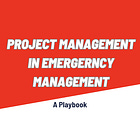Strategy → Action, Cyber Startups, War Capabilities & More
Profiles in Preparedness #32
A lot of effort and attentions goes into creating organizational strategies. Breaking down complex environment, identifying opportunities, defining your bid for success. It's fun. It's energizing. It gets people people focused and motivated, at least in the moment, on what is possible.
But not everyone sees their strategy pay off. One key difference between organizations that successfully turn their visionary ideas into tangible results, and those that falter, is often their ability to operationalize their strategic commitment.
Management systems and governance frameworks might lack the immediate appeal of strategy workshops or creative ideation sessions, but they’re vital for translating vision into consistent action.
If strategy defines your organization's direction, governance is the navigation system guiding you there.
Effective management systems create the necessary infrastructure—clear roles, precise decision-making processes, defined responsibilities—to maintain momentum, avoid drift, and adapt quickly as circumstances evolve.
Thoughtfully designed, these governance structures become enablers, allow your teams to adjust and adapt, maintain strategic discipline, and shapes a culture that integrates frontline insights into leadership decisions.
If your ambition is to truly stay "left of bang"—ahead of the market shocks, competitive threats, tech changes, or internal crises—then pair your strategic vision with a management system powerful enough to make it reality.
Inside The CP Journal
Here are some of the articles that were added to the site this week.
How an Office of Emergency Management organizes itself to effectively prepare for disasters is a critical decision. This article makes the case for why a Project Management Office (PMO) structure is an incredibly effective way to grow an office’s projects, programs, and portfolio of capabilities.
P.S. If you’d like on-call help turning ideas into action and projects into capabilities, reply to this email with “advisor,” and we can spend 30 minutes working through a priority you’re stuck on.
What to do with general alerts—as opposed to specific alerts—remains one of the most persistent leadership challenges in public safety and corporate security.
This "play" for Academy subscribers walks through some steps when a heightened cyber threat, increased geopolitical tensions, or an elevated severe weather event threatens, but lacks the clear targeting or timing needed for a proactive, yet balanced, response.
This Week‘s Reads
Here are a few standout reads from this week with insights, ideas, and perspectives that caught my attention.
Podcast | Left of Bang: How to Predict Crisis, Seize Advantage, and Win Before the Fight Starts.
I had the chance to talk with Mark McGrath and Brian Rivera from The Whirl of ReOrientation: Escape the Script. Win the War. and about a wide range of “left of bang” focused topics.
Give the podcast a listen and consider subscribing to their newsletter.
Article | Is Europe prepared for war?
This story from the Financial Times looks at the preparations European countries are making in case Moscow decides to test NATO's defensive resolve.
Here is why I'm sharing this article. Often when the press talks about "capabilities", they talk about equipment and hardware. This article gloriously covers all the elements that actually go into a capability.
It highlights plans, based on risk assessments and grounded in assumptions.
It looks at the people and partners required to implement the plans and the training and education needed to ensure those groups can be successful in executing the plan.
It encompasses the resources (equipment, facilities, supplies, technology, and funding) required to implement the plan.
It shows the validation events and exercises needed to know whether the capability can perform to expectations.
Will it be enough? I have no idea and will leave that to people with more than zero experience studying Europe’s eastern flank, but I appreciate the discussion on a full capability assessment.
Article | How startups work: a field guide for security people.
Public safety and corporate security aren't quite at the same level as cybersecurity in terms of startups. But the number is growing fast and is unlikely to slow down.
This article breaks down 10 aspects of how cybersecurity startups operate, which I believe public safety and security professionals would benefit from understanding. The parallels are everywhere.
Article | Why Iran Is a Scaredy Cat Cyber Chicken.
As we've covered in our Watch Office reports over the last few weeks, "US authorities and security firms have spent the last few weeks pumping out non-stop warnings about an increased threat of Iranian cyber attacks targeting US critical infrastructure. At the time of writing, these attacks have not materialized."
While there may or may not have been pre-event indicators that led to these warnings, they also stem from a straightforward "action and reaction" thought process. This article does a good job of looking at reasons why the reaction might not have occurred.
"Given the US has already dropped very real bombs, we think Iran has good reason to avoid escalatory cyber attacks....These types of attacks are useful and worthwhile before bickering between states escalates to armed conflict." They are “tools of first resort.”
Article | Low Battery: ‘Heat Dome’ Exposes Cracks in America’s Decaying Power Grid.
Just a reminder that it isn't just the external threats that we should be focused on, sometimes it’s our own decisions that lead to disasters.
When You’re Ready
If you want more in-depth insights, you can become a paying subscriber to access exclusive content like our weekly Watch Office situation reports, our Tactical Analysis Course & behavioral analysis practice exercises, and the “Project Management in Emergency Management” Playbook.
And if you’re thinking about how to strengthen your organization's preparedness, that’s what we do. Whether it’s assessments, planning, speaking events, or exercises, we help teams build the skills and strategies to stay ahead of the next challenge.



